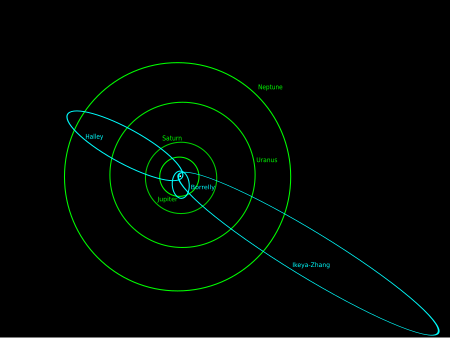153P/Ikeya–Zhang
 Comet Ikeya–Zhang photographed by Philipp Salzgeber on 1 April 2002 | |
| Discovery | |
|---|---|
| Discovered by | Kaoru Ikeya Zhang Daqing |
| Discovery date | 1 February 2002 |
| Designations | |
| C/2002 C1, C/1661 C1[1] | |
| Orbital characteristics[3] | |
| Epoch | 8 May 2002 (JD 2452402.5) |
| Observation arc | 403 days (1.10 years) |
| Earliest precovery date | 3 February 1661[2] |
| Number of observations | 1,893 |
| Aphelion | 101.73 AU |
| Perihelion | 0.507 AU |
| Semi-major axis | 51.119 AU |
| Eccentricity | 0.99008 |
| Orbital period | 365.49 years |
| Max. orbital speed | 59 km/s (2002-03-18) |
| Min. orbital speed | 0.29 km/s[a] (2182-Nov-24) |
| Inclination | 28.121° |
| 93.369° | |
| Argument of periapsis | 34.668° |
| Mean anomaly | 0.135° |
| Last perihelion | 18 March 2002[3][4] 29 January 1661[5] |
| Next perihelion | 1 September 2362[5] 14 March 2363[6] |
| TJupiter | 0.879 |
| Earth MOID | 0.332 AU |
| Jupiter MOID | 0.011 AU |
| Physical characteristics[3][7] | |
| 1.48±0.2 days | |
| Comet total magnitude (M1) | 4.0 |
| 2.9 (2002 apparition) | |
Comet Ikeya–Zhang (Japanese, Chinese: 池谷-張彗星, officially designated 153P/Ikeya–Zhang) is a comet discovered independently by two astronomers from Japan and China in 2002. It has by far the longest orbital period of the numbered periodic comets. It was last observed in October 2002 when it was about 3.3 AU (490 million km) from the Sun.[3]
Discovery and observations
[edit]On 1 February 2002, Chinese astronomer Zhang Daqing from Kaifeng discovered a new comet in the constellation Cetus, and reported it to the IAU. He found that Japanese astronomer Kaoru Ikeya had discovered it earlier than he had, as the time of sunset is earlier than China. According to tradition, since they discovered the new comet independently, the comet was named after both of them. The comet was initially designated as C/2002 C1 (Ikeya–Zhang).
The comet was observed in 1661, 341 years earlier, by Polish astronomer Johannes Hevelius.[8][2] A bright comet had also been recorded by Chinese astronomers in 1661.[2]
The permanent designation "153P" was given to the comet. It has the longest known orbital period of any periodic comet (366.51 years). Its orbital speed around the Sun varies from 59 km/s (37 mi/s) at perihelion to 0.29 km/s (0.18 mi/s) at aphelion.[a]
The comet passed perihelion on 18 March 2002, and with apparent magnitude 2.9. With a multi-hundred year orbit involving asymmetric outgassing the next perihelion passage is expected between 2362–2363. During March–April 2002, protons from the comet tail may have been detected by the Cassini–Huygens spacecraft. This data suggested the comet tail had a length greater than 7.5 AU (1.12 billion km), making it the longest yet detected.[9]
Orbit
[edit]
See also
[edit]References
[edit]Notes
[edit]Citations
[edit]- ^ G. W. Kronk. "153P/Ikeya–Zhang". Cometography.com. Retrieved 19 October 2017.
- ^ a b c G. W. Kronk; M. Meyer; D. A. J. Seargent (1999). Cometography: A Catalog of Comets. Vol. 1: Ancient–1799. Cambridge University Press. pp. 348–350. ISBN 978-0-521-58504-0.
- ^ a b c d "153P/Ikeya–Zhang – JPL Small-Body Database Lookup". ssd.jpl.nasa.gov. Jet Propulsion Laboratory. Retrieved 20 April 2011.
- ^ "153P/Ikeya–Zhang". www.minorplanetcenter.net. Minor Planet Center. Retrieved 25 February 2019.
- ^ a b S. Nakano (13 August 2002). "153P/Ikeya-Zhang". OAA Computing and Minor Planet Sections. Retrieved 4 October 2009.
- ^ "Horizons Batch for 153P/Ikeya–Zhang (90001080) on 2363-Mar-14" (Perihelion occurs when rdot flips from negative to positive). JPL Horizons. Retrieved 10 April 2021. (JPL#74/Soln.date: 2020-Jun-17)
- ^ F. Manzini; G. Schwarz; C. B. Cosmovici; C. Guaita; et al. (2007). "Comet Ikeya-Zhang (C/2002 C1): Determination of the Rotation Period From Observations of Morphological Structures" (PDF). Earth, Moon and Planets. 100 (1–2): 1–16. Bibcode:2007EM&P..100....1M. doi:10.1007/s11038-005-9062-6.
- ^ D. W. Green (2004). Assessment of early-modern observations of Comets and Supernovae: Focus on Pre-telescopic European astrometric and physical data (PDF) (Doctoral thesis). Durham University. pp. 213–228.
- ^ G. H. Jones; H. A. Elliott; D. J. McComas; M. E. Hill; et al. (2020). "Cometary Ions detected by the Cassini spacecraft 6.5 AU downstream of Comet 153P/Ikeya-Zhang" (PDF). Icarus. 388: 15199. arXiv:2006.00500. Bibcode:2022Icar..38815199J. doi:10.1016/j.icarus.2022.115199.
External links
[edit]


